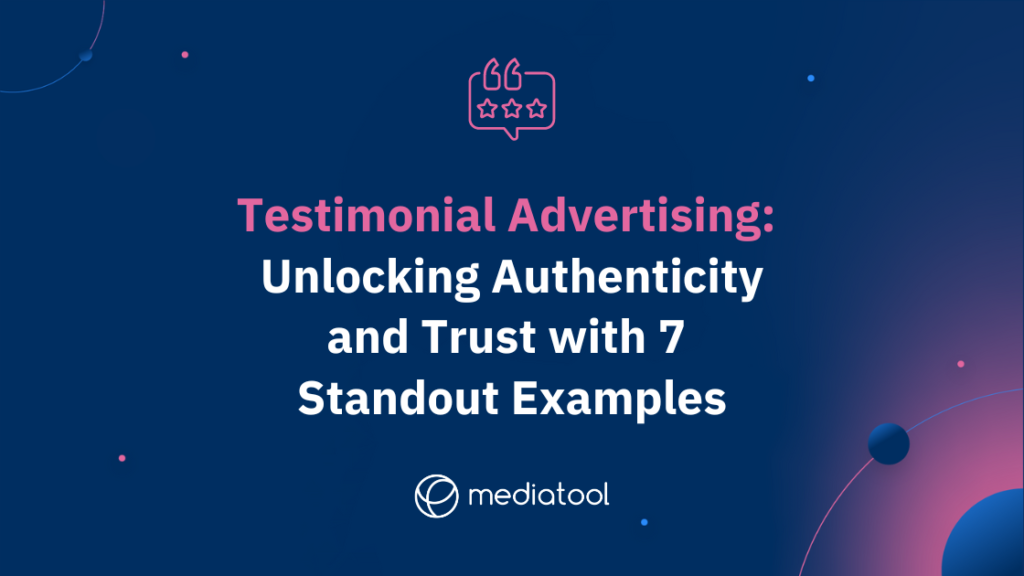Introduction to Testimonial Advertising
You’ve come across this article because you’re intrigued about one of the most potent tools in the modern marketer’s toolbox – testimonial advertising.
You might not know it yet, but you’ve already seen it, heard it, and perhaps even felt the impact of it. And we bet you’re itching to know more about it, right?
As we dive into the world of testimonial advertising, we’ll start with the basics and the power of testimonials – as they tap into our inherent trust in peers, in people like us, making us more receptive to a product’s appeal.
Testimonial advertising isn’t just about slapping on a quote from a satisfied customer. It’s about reaping benefits that can revolutionize a brand’s identity and its connection with the audience. From building trust with customers to bolstering credibility, showcasing real-world usage, and driving conversions – testimonials can do it all!
In this article we’ll cover real-world examples of testimonial advertising. Slack, Shopify, Airbnb, and more – we’ve got a lineup of brands that have masterfully utilized testimonials for their gain.
In a nutshell, this article is your key to understanding the why, what, and how of testimonial advertising.
Ready? Let’s dive in!
What is Testimonial Advertising?
Testimonial advertising is a potent marketing approach where businesses leverage the positive experiences and feedback from their customers to endorse their products or services. This strategy extends beyond mere word-of-mouth recommendations, transforming satisfied customers’ endorsements into compelling and authentic marketing materials.
Picture this scenario: You visit a top-rated restaurant and can’t resist sharing your fantastic experience with friends, colleagues, and even your gym partner.
This act of sharing your satisfaction is a testimonial.
If the restaurant uses your enthusiastic endorsement in their ad campaigns, with your permission, you transition from a mere patron to an integral part of their marketing efforts.
That’s testimonial advertising for you.
Testimonial advertising is not limited to individual consumer experiences. B2B (Business to Business) testimonials are also prevalent, where companies use endorsements from other businesses to establish credibility and illustrate potential success for prospective customers.
For instance, a software firm might showcase a testimonial from a renowned corporation that benefits from their product, enhancing the software’s appeal and demonstrating its effectiveness to potential clients.
Testimonial ads come in various forms, including customer testimonials, video testimonials, and social media ads. These could range from text customer testimonials to elaborate video testimonial ads, each serving as a unique testament to a product’s or service’s value.
Businesses might feature these testimonials on a dedicated testimonial page, within blog posts, or even in email campaigns, effectively using them across various marketing channels.
The authenticity of testimonials is their core strength. Real stories from actual customers—whether they are in the form of customers success stories, interview testimonials, or even influencer testimonials—offer social proof that transcends the impact of fictional advertising narratives.
They resonate with the target audience, providing relatable and genuine social proof, crucial for building brand credibility and fostering business growth.
Remember, effective testimonial ads, whether they’re part of digital advertising, print ads, or integrated into social media posts, hinge on the genuine, positive feedback of happy customers.
Their real-world experiences and customer quotes not only foster trust but also encourage other potential customers to make more informed decisions, leading to more sales and enhanced brand reputation.
Make sure you’re not creating a strategy to promote fake online reviews. Here are some insights from a recent survey about some things to consider when developing your testimonial strategy.
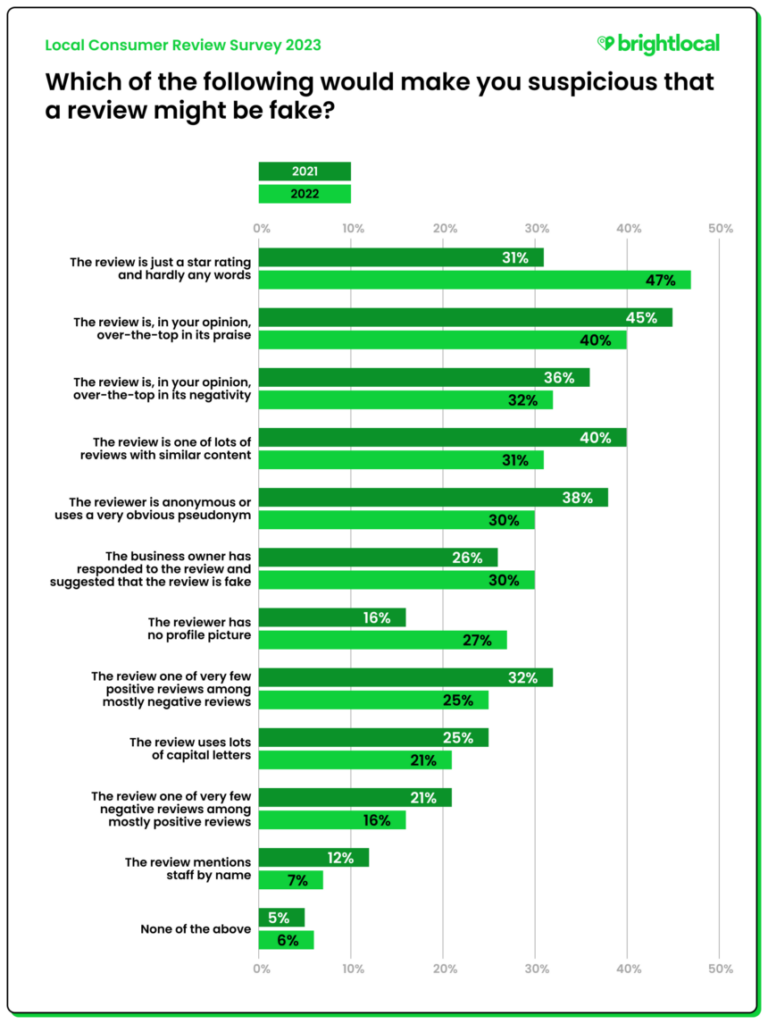
So, what’s the takeaway here? Testimonial advertising isn’t just about using customer feedback. It’s about showcasing real-life experiences, about giving your audience proof that your product or service delivers what it promises.
And in a world where consumers are bombarded with countless advertising messages every day, that kind of authenticity and trustworthiness can make all the difference.
So next time you see a quote from a satisfied customer in an ad, remember – that’s testimonial advertising, weaving its magic!
Why do Advertisers Use Testimonials?
Let’s break down this crucial question – why are advertisers so smitten with testimonials?
Establishing Trust through Social Proof
Advertisers favor testimonials because they act like a credible, unbiased friend – an independent third party who has experienced the product or service firsthand and can vouch for its value.
This element of ‘social proof’ is a key factor.
Social proof is a psychological phenomenon where individuals emulate the actions of others to mirror appropriate behavior in a given context.
Testimonials, including customer stories and quote testimonials, provide this assurance, showing potential customers that others have enjoyed positive experiences with a product or service, thereby building trust and credibility.
Adding a Human Touch to Digital Interactions
In the digital realm, where many interactions lack a personal connection, testimonials bring a human element to advertising.
They showcase real-life examples of product or service usage, enabling prospective customers to see how these offerings could integrate into their lives.
This aspect is particularly effective in video testimonials, such as a Facebook video testimonial ad or video testimonial advertising examples, where the customer’s experience and voice are highlighted, making the advertising more relatable and genuine.
Addressing Customer Concerns
Testimonials also play a crucial role in addressing potential customer concerns or objections. For example, a testimonial video emphasizing the ease of using a product can alleviate worries about its complexity.
These authentic testimonials, whether in the form of text testimonials, video testimonial ads, or testimonial commercials, provide direct responses to specific hesitations, helping to guide decisions.
Driving Conversions and Sales
A pivotal benefit of testimonials in advertising campaigns is their ability to drive conversions and sales.
They offer tangible proof of a product’s benefits, encouraging potential customers to transition from considering a purchase to actually making it.
Testimonial ad examples, including customer success stories and success story testimonials, effectively demonstrate the product’s impact, nudging customers towards a purchase.
Testimonials: A Triple Threat in Advertising
Testimonials deliver a powerful combination of benefits in advertising:
- Building Trust: They establish credibility and trust among the target audience through social proof.
- Showcasing Real-Life Usage: Testimonials, especially in formats like video testimonials or testimonial videos, bring a product or service to life, presenting real-world applications.
- Driving Conversions: They provide concrete evidence that encourages customers to make a purchase, supported by positive comments from satisfied customers.
In a marketing industry saturated with self-promotion and hyperbolic claims, testimonials stand out as authentic, trustworthy, and relatable, guiding consumers towards informed purchasing decisions.
This effectiveness in resonating with the target market, whether through traditional ad copy, social media platforms, or video testimonial advertising, is why testimonials are a mainstay in the repertoire of savvy advertisers.
Types of Testimonial Advertising
So, you’ve caught on to why testimonials are a big deal. But did you know there’s not just one but several types of testimonial advertising? And each testimonial ad example has its unique flavor and impact.
Customers Testimonials
These are the testimonials from everyday folks who have used and loved a product or service. You’ve seen them everywhere, from website product pages to social media posts.
They’re from people like you and me, sharing our positive experiences.
What makes them special?
They’re highly relatable! When potential customers read these testimonials, they see a reflection of their needs and aspirations, making them incredibly persuasive.
Celebrity Endorsements
Who hasn’t seen their favorite movie star or sports personality in an ad, right? When celebrities endorse products, they bring along their charm, popularity, and influence.
Their testimonials can reach and resonate with a vast audience.
But remember, the product needs to align with the celebrity’s image for the endorsement to seem genuine.
Influencer Testimonials
In today’s digital world, influencers on platforms like Instagram, YouTube, and TikTok have amassed significant followings. When they share their favorite products, their followers listen – especially Gen z.
Influencer testimonials are a unique blend of relatability and aspiration. They’re not as distant as celebrities, yet they’re admired and respected, making their recommendations highly effective.
Expert Opinions
Ever seen a toothpaste ad with a dentist or a skincare product recommended by a dermatologist? Those are expert opinions. They lend authority and credibility to the product, reassuring customers about its quality and effectiveness.
Here’s the catch: a testimonial’s impact greatly depends on its relevance to the audience. A celebrity testimonial might work wonders for a fashion brand targeting young adults, but an expert opinion might be more persuasive for a brand selling skincare products.
It’s all about knowing who your audience trusts and admires.
To sum up, the types of testimonial advertising are as diverse as the customers themselves. Each type caters to a different aspect of consumer psychology – relatability, aspiration, respect for authority, or trust in peers.
Benefits of Testimonial Advertising
Now that you’ve become familiar with the ‘what’ and ‘why’ of testimonial advertising, let’s look at the ‘wow’ factor, specifically the benefits this powerful strategy offers businesses. Spoiler alert: there are plenty!
First off, testimonials offer something that’s increasingly becoming the holy grail of marketing – authenticity.
In an era where consumers are surrounded by advertising messages from all sides, they seek genuine, honest interactions. Testimonials, by their very nature, deliver that authenticity.
They come from real people sharing their real experiences. This honest portrayal can win over customers more effectively than any polished marketing claim.
This leads us to the second benefit, trust, and credibility.
People trust people. When potential customers read or watch a testimonial, they hear from someone who has already interacted with the product or service. They’re hearing from someone like themselves. This helps to foster a sense of trust and can significantly enhance a company’s credibility.
Thirdly, testimonials help counter skepticism.
Let’s face it, we’re all a little doubtful when purchasing, especially if it involves parting with a significant amount of money. Testimonials can help ease these concerns by presenting positive experiences from previous customers. They can also address potential objections or misconceptions, serving as a potent tool in the fight against consumer skepticism.
Next up, testimonials aid in storytelling.
Remember the last time you were engrossed in a good story? Didn’t it feel personal and real? Testimonials weave personal narratives around products or services, presenting them in a relatable context. They demonstrate how the product fits into real lives and solves real problems. This can greatly enhance a brand’s emotional connection with its audience.
Finally, testimonials have a direct impact on conversion rates and sales.
By easing skepticism, building trust, and showcasing real-life usage, testimonials guide potential customers further down the sales funnel. They can help turn a hesitant browser into a committed buyer.
So, let’s recap. Testimonials offer authenticity in a landscape often filled with inflated claims. They build trust, combat skepticism, enhance storytelling, and drive conversions. Their power lies in their simplicity – real people sharing real experiences. And that’s a benefit any smart business wouldn’t want to miss out on!
How To Get More Customer Testimonials
Now that we’re all on the same page about the power of testimonials, the next question is, “How do I get more customer testimonials?”
The first and most straightforward strategy is to ask for them.
It may seem simple, but it’s often overlooked. Reach out to your customers and request their feedback. This can be done post-purchase or after the delivery of a service. It can be as simple as an email, a survey, or even a phone call.
Remember, the key here is to make it easy for the customer. Provide a clear, direct way for them to share their experiences.
Next up, consider using social media.
Platforms like Facebook, Twitter, Instagram, and LinkedIn are rife with customer feedback. Monitor your brand mentions, comments, and messages. You might find customers already sharing positive experiences with your brand. Always seek permission before using these posts as testimonials, but don’t hesitate to reach out!
Another strategy is to offer incentives.
People love getting something in return for their efforts. You could offer a discount, a small freebie, or even enter them into a draw to win a bigger prize. This incentivizes customers to share their experiences and can often yield a higher response rate.
Case studies and long-form testimonials are another valuable avenue to explore.
These involve deep diving into a customer’s experience, demonstrating how your product or service solved their problem. They require more effort from you and the customer, but the payoff can be immense. A well-crafted case study can provide compelling evidence of your product’s value.
Finally, don’t forget about video testimonials.
With the increasing consumption of video content, a video testimonial can be a highly engaging way to showcase your customer’s experiences. They are more personal and expressive and can convey nuances that text simply can’t.
One last thing to remember: always respect your customers’ privacy. Obtain their consent before using their feedback as a testimonial, and ensure you adhere to all relevant privacy regulations.
So, there you have it! Five strategies to increase your cache of customer testimonials. From asking directly to leveraging social media, offering incentives, exploring case studies, and embracing video testimonials, you’ve got many options.
Remember, the goal is to showcase genuine, positive experiences with your brand. With these tips, you’re well on your way to harnessing the power of testimonials in your advertising!
Testimonial Advertising Examples
Okay, folks, we’ve now reached the grand finale of our testimonial advertising journey. And what better way to wrap things up than to peek at some real-world examples? Here are ten standout testimonial advertisements.
1. Slack
Slack, a team collaboration tool, features a glowing video testimonial ad from Vodafone on their homepage. The testimonial is a detailed account of how Slack transformed their communication, improving efficiency and organization. The user’s name, title, and company accompany the testimonial, adding to its credibility.
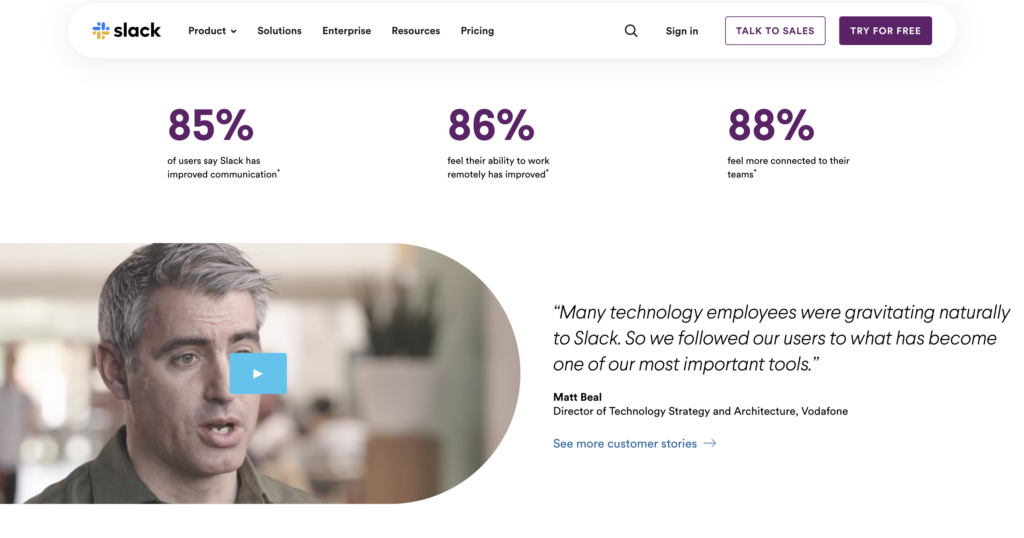
2. Codecademy
This online coding platform has a dedicated ‘Learner Stories‘ section. Here, they share testimonials of users who have successfully switched careers or launched their own projects after learning to code on the platform. Each story is engaging, has personal details, and is inspiring.
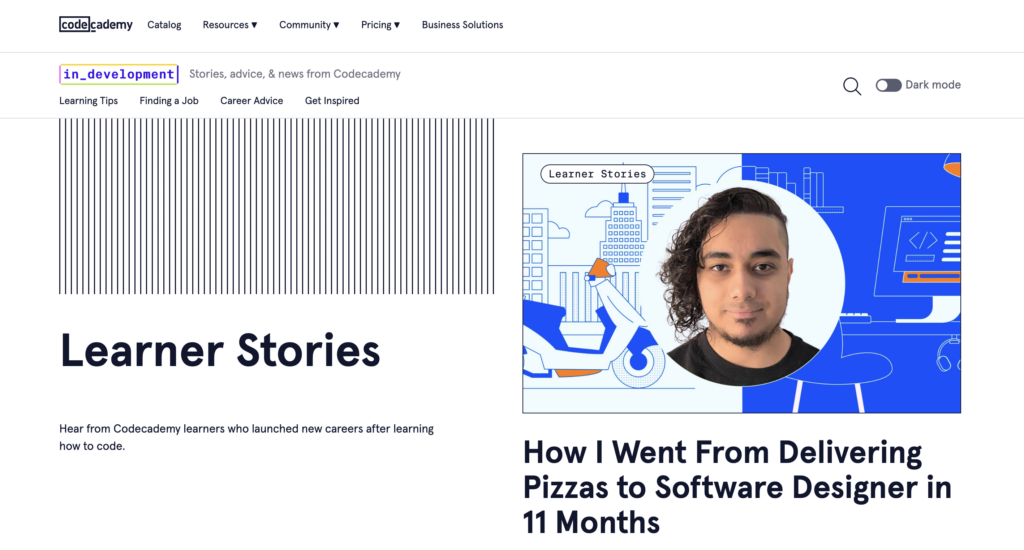
3. Airbnb
Airbnb’s ‘Host Stories‘ section on their website is a fantastic example of testimonial advertising. Here, hosts from around the world share their experiences of opening their homes to travelers. These testimonials provide authentic, heartfelt stories that reinforce the Airbnb brand.
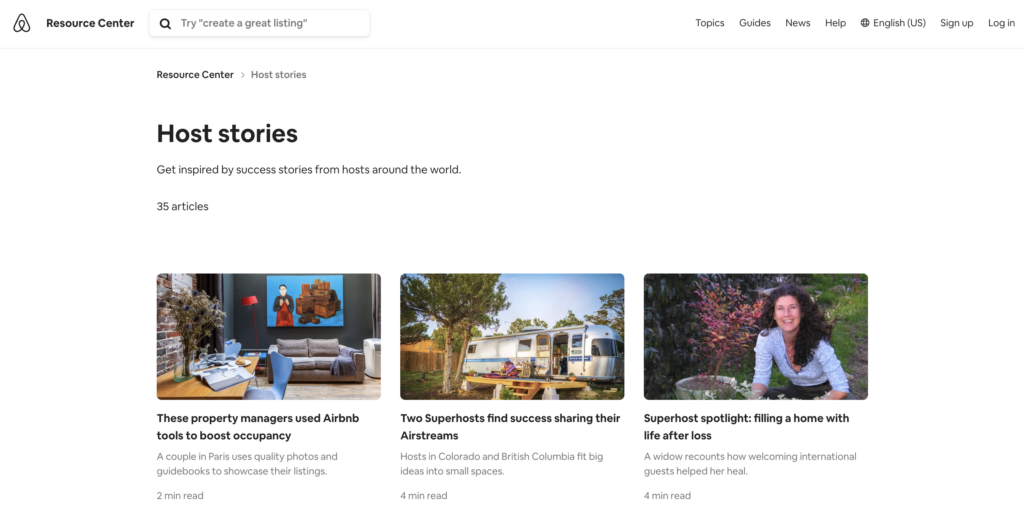
4. Zoom
Video conferencing giant Zoom uses customer testimonials in various ways, including on social media. They often share customer tweets praising their services. This showcases positive feedback and encourages other customers to share their experiences on social platforms.
5. Shopify
Shopify shares success stories of their merchants on their site. Each story dives into how Shopify has helped these businesses succeed online. The testimonials are detailed, accompanied by engaging photos and measurable results, bolstering their credibility.
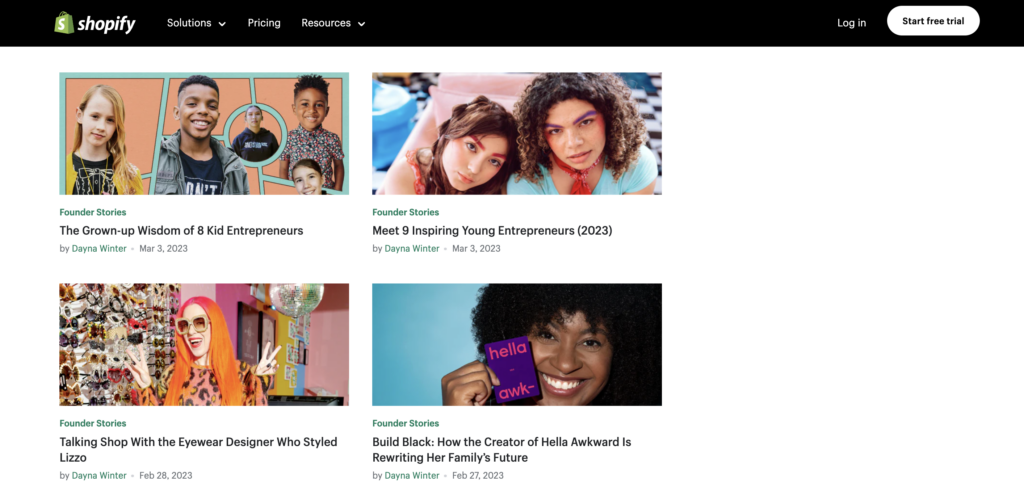
6. FreshBooks
FreshBooks uses customer testimonials on their homepage. The testimonial, accompanied by the customer’s name, photo, and company, offers social proof and can help convince website visitors to try the product.
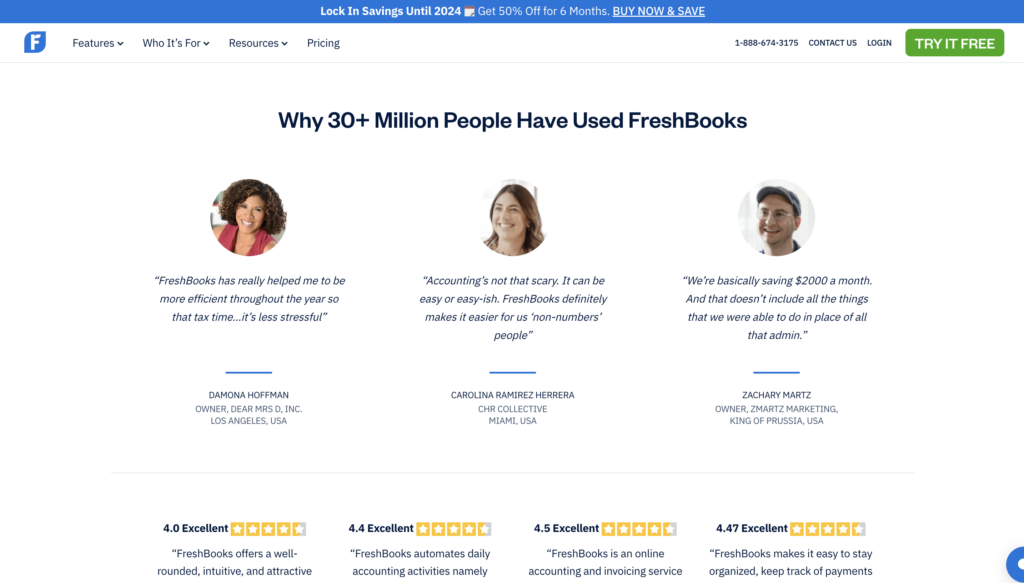
7. Glossier
Beauty brand Glossier has leveraged user-generated content as testimonials. They share customer reviews and before-after photos on Tiktok, demonstrating the real-life results of their products.
Each of these examples showcases the versatility and impact of a testimonial advertising strategy. They’re relatable, authentic, and persuasive, reinforcing the brand message and winning customer trust.
What’s Next?
So, we’ve dived deep into testimonial advertising, unearthing its definition, purpose, types, benefits, strategies to get more testimonials, and some standout examples. But what’s the next step on this exciting journey?
Having these powerful tools in your advertising arsenal is just the beginning.
Take a moment and envision your ad planning, measuring, and reporting elevated to the next level. Sounds appealing, doesn’t it? This is where Mediatool comes in. It’s the game-changer you need to manage your media planning effectively and efficiently. Mediatool is a media management platform designed to streamline your advertising process, from planning to tracking, and reporting.
With Mediatool, you can centrally manage all your advertising activities. Whether tracking your testimonial advertisements’ performance, planning your next big campaign, or generating comprehensive reports, Mediatool has got you covered.
You can visualize your media plans, monitor your budgets, and evaluate your ROI, all within a single platform.
Mediatool also enables collaboration across teams, ensuring everyone is on the same page. The intuitive, user-friendly interface ensures a seamless experience, helping you confidently make data-driven decisions.
Ready to take your advertising to new heights? Take a tour of Mediatool today.
